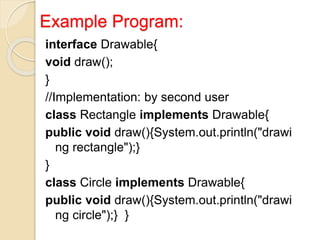Interface in java
- 1. Interface in Java -Arulkumar V Assistant Professor, SECE
- 2. Interface in Java An interface in java is a blueprint of a class. It has static constants and abstract methods. The interface in java is a mechanism to achieve abstraction. There can be only abstract methods in the java interface not method body. It is used to achieve abstraction and multiple inheritance in Java. Java Interface also represents IS-A relationship.
- 3. Why use Java interface? There are mainly three reasons to use interface. They are given below. It is used to achieve abstraction. By interface, we can support the functionality of multiple inheritance. It can be used to achieve loose coupling.
- 5. Example of Interface interface printable{ void print(); } class A6 implements printable{ public void print(){System.out.println("Hello");} public static void main(String args[]){ A6 obj = new A6(); obj.print(); } } Printable interface has only one method, its implementation is provided in the A class.
- 6. Example Program: interface Drawable{ void draw(); } //Implementation: by second user class Rectangle implements Drawable{ public void draw(){System.out.println("drawi ng rectangle");} } class Circle implements Drawable{ public void draw(){System.out.println("drawi ng circle");} }
- 7. //Using interface: by third user class TestInterface1{ public static void main(String args[]){ Drawable d=new Circle();//In real scenario, obj ect is provided by method e.g. getDrawable() d.draw(); }} Cont.,
- 8. Bank example interface Bank{ float rateOfInterest(); } class SBI implements Bank{ public float rateOfInterest(){return 9.15f;} } class PNB implements Bank{ public float rateOfInterest(){return 9.7f;} }
- 9. Cont., class TestInterface2{ public static void main(String[] args){ Bank b=new SBI(); System.out.println("ROI: "+b.rateOfInter est()); }} Output: ROI: 9.15
- 10. Multiple inheritance in Java by interface If a class implements multiple interfaces, or an interface extends multiple interfaces i.e. known as multiple inheritance.
- 11. Multiple inheritance example interface Printable{ void print(); } interface Showable{ void show(); } class A7 implements Printable,Showable { public void print(){System.out.println("Hello"); } public void show() {System.out.println("Welcome");} public static void main(String args[]) { A7 obj = new A7(); obj.print(); obj.show(); } } Output: Hello Welcome
- 12. Interface inheritance A class implements interface but one interface extends another interface . interface Printable{ void print(); } interface Showable extends Printable{ void show(); } class TestInterface4 implements Showable{ public void print(){System.out.println("Hello");} public void show(){System.out.println("Welcome");} public static void main(String args[]){ TestInterface4 obj = new TestInterface4(); obj.print(); obj.show(); } } Hello Welcome
- 13. Thank You 19-12-2017 Sampath Kumar.S, AP/IT 13





![Example of Interface
interface printable{
void print();
}
class A6 implements printable{
public void print(){System.out.println("Hello");}
public static void main(String args[]){
A6 obj = new A6();
obj.print();
}
}
Printable interface has only one method, its
implementation is provided in the A class.](https://image.slidesharecdn.com/interfaceinjava-171219100319/85/Interface-in-java-5-320.jpg)

![//Using interface: by third user
class TestInterface1{
public static void main(String args[]){
Drawable d=new Circle();//In real scenario, obj
ect is provided by method e.g. getDrawable()
d.draw();
}}
Cont.,](https://image.slidesharecdn.com/interfaceinjava-171219100319/85/Interface-in-java-7-320.jpg)

![Cont.,
class TestInterface2{
public static void main(String[] args){
Bank b=new SBI();
System.out.println("ROI: "+b.rateOfInter
est());
}}
Output:
ROI: 9.15](https://image.slidesharecdn.com/interfaceinjava-171219100319/85/Interface-in-java-9-320.jpg)

![Multiple inheritance example
interface Printable{
void print();
}
interface Showable{
void show(); }
class A7 implements Printable,Showable
{
public void print(){System.out.println("Hello");
}
public void show()
{System.out.println("Welcome");}
public static void main(String args[])
{
A7 obj = new A7();
obj.print();
obj.show(); } }
Output: Hello
Welcome](https://image.slidesharecdn.com/interfaceinjava-171219100319/85/Interface-in-java-11-320.jpg)
![Interface inheritance
A class implements interface but one interface extends another
interface .
interface Printable{
void print();
}
interface Showable extends Printable{
void show();
}
class TestInterface4 implements Showable{
public void print(){System.out.println("Hello");}
public void show(){System.out.println("Welcome");}
public static void main(String args[]){
TestInterface4 obj = new TestInterface4();
obj.print();
obj.show();
}
} Hello
Welcome](https://image.slidesharecdn.com/interfaceinjava-171219100319/85/Interface-in-java-12-320.jpg)
